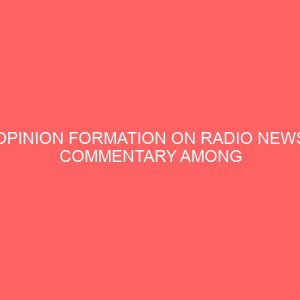Description
CHAPTER ONE
INTRODUCTION
1.1 BACKGROUND OF THE STUDY
Insurance can be seen from many points of view according to Hezen Ibeabuchi I. (2000) introduction to insurance, she postulate that insurance is a process of transferring a risk from one party to another. Secondly, insurance can be defined as a contract between two parties the insurer and the insured (proposer), whereby the insured pay a relative amount of money called premium to that the insurer will undertaken his risk and pay sum insured (indemnity) if the risk of the insured occur at a contracted period of time.
Thirdly, we can say that insurance is whereby the many fortunate ones compensate the few unfortunate ones. Finally, we can say that insurances is a self guide against risk.
Motor vehicle first appeared on the roads during the year 1880s and the flue first motor insurance policies were issued during the 1890s. In drawing up this new type of policies insures were influenced by their experience of fire, theft and liability insurance and as a result of that they placed more emphasis on the subject matter of the insurance (the vehicle) for rating purposes than they did up on the driver.
Nowadays, they give more weight to the driver and his experience; particularly, to the boung driver. The early bears of the twentieth century saw for formation of insurance companies in which the main emphasis was upon motor.
The experience of the theft and liability insurance influenced the development of composite companies and when motor vehicle appeared on the roads in larger number after the 1st world war, motorists offices. By the late 1920s these offices, most of which belonged to the Accident Offices Association (include within the Association of British insurer on its formation during 1985) had come to realize that their joint and several interests would best be served if they were to agree to adopt a more or less standard set of guidelines and basis rates for motor insurance.
During the Second World War competition for motor insurance subsided. One reason among other was that there were few vehicles in private use.
After the war, however, established motor insurers picked up more or less where they had left off but a news, feature was the appearance of what came to be known as “mushroom” companies.
These aimed for first growth by offering lower premiums and higher rates of commission and by managing limit operational expenses through streamlining administrative and underwriting methods.
For example, they gave brokers, increased underwriting authority and required them to prepare endorsements and to process claims for early settlement are of the companies was the first to prepare policies by computer. The increased competition provides by such companies was largely responsible for the abolition of the tariff in 1968. These mushroom companies not have sufficient skill to maintain adequate solvency margin and the result was a serious of bankruptcies.
These lead to demands for greater control ever for nationalization of motor insurance, demands which have been strenuously resisted by insurance and may members of the public.
INTRODUCTION OF COMPULSORY MOTOR INSURANCE
After the end of 1914 -18 war, the number of vehicles in road increased very well and this led to an increase in road accident. Those injured through the fault of motorists were not able to obtain compensation because the motorist may be uninsured end without efficient resources to pay damage. These things led to the introduction of Road Traffic Act 1930 which imposed for the first time a statutory obligation on the users of all motor vehicles to provide security against their legal liability for causing death or bodily injury to the third parties. In 1972, the Act was to include the liabilities of a motorist to passengers in his own vehicle. The compulsory third party insurance law was consolidated into part VI of the Road Act 1974 and was amended by the Road Traffic Act 1974.
TYPES OF MOTOR INSURANCE POLICY
– Road Traffic Act Policy
– Third Party only Policy
– Third Party, Five and Theft policy
– Comprehensive policy
1.2 STATEMENT OF PROBLEMS
In this section, the researcher focused on the prevalent problems facing economic importance of motor insurance in our society.
1. Lack of adequate compensation concerning injury and damage to the third party.
2. Low management of motor insurance contract.
3. Inadequate existence of uninsured vehicle the high way
4. Lack of adequate information of motor insurance contract.
5. Low level promotion of motor insurance business.
6. Lack of adequate service rendered by insurance middlemen
7. Inadequate of claim settlement of motor insurance
8. Inadequate cover of motor insurance business
9. Lack of encouragement from the insurer and middlemen.
10. Lack of risk management of motor insurance contract.
1.3 OBJECTIVE OF THE STUDY
The objective that made the researchers go into this topic are as follows.
a. To determine the economic importance of motor insurance in our society
b. To find out a strategy that can help in the developing of motor insurance in our society
c. To determines the reason for lack information of motor insurance contract.
d. To determine the reason for lack of adequate compensation
e. To determine the cause of low management of motor insurance contract.
f. To determine the cause of low level services of the middlemen.
1.4 SIGNIFICANCE OF THE STUDY
i. The significance of this study is to achieve a great success and to solve some prevalent problems encounter in motor insurance contract.
ii. It will equally help to expose to the entire citizen or public the important of motor insurance contract.
iii. It will create a strategy for developing and improvement of motor insurance practice in Nigeria.
iv. Finally, the result that we generated from this research work, will be immense benefit to all management staff of motor insurance in Nigeria and as well as student conducting similar research work on the same topic or topic related to it.
1.5 SCOPE AND LIMITATION OF THE STUDY
In the course of this study, one would like together data from many areas. But in view of length of time allowed for this research, such a wide ranges sample study was almost external difficult. Therefore, the researcher we concentrate his field work within Enugu metropolis. The choice of Enugu metropolis was based on the time factor allowed and upon practical considerations including the fact that the research follows almost everything about Enugu metropolis.
Besides, there are many problems that we encounter when carrying out the researcher work.
a. Financial constraint:- As a student, there was not enough capital to spend in transport and fact finding and borrowing of necessary literature that would have helped in the writing of this research work.
b. Time factor:- As a result of short time and fastness of examination approach we did not have a lot of time to cover the areas we supposed to cover.
1.6 DEFINITION OF TERMS
Motor: Can be defined as any mechanically propelled engine which has more than three tyres and plys on the roads.
Society: A system in which people live together in organized communities.
Economics: This is the principle of the productions and distribution of goods and services and development of wealth.
Contract: It is a legal agreement between two parties which is recognized by law court.
Insurance: Is a person who is a professional in insurance business. There are the people that practice insurance in insurance industries.






